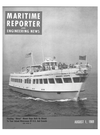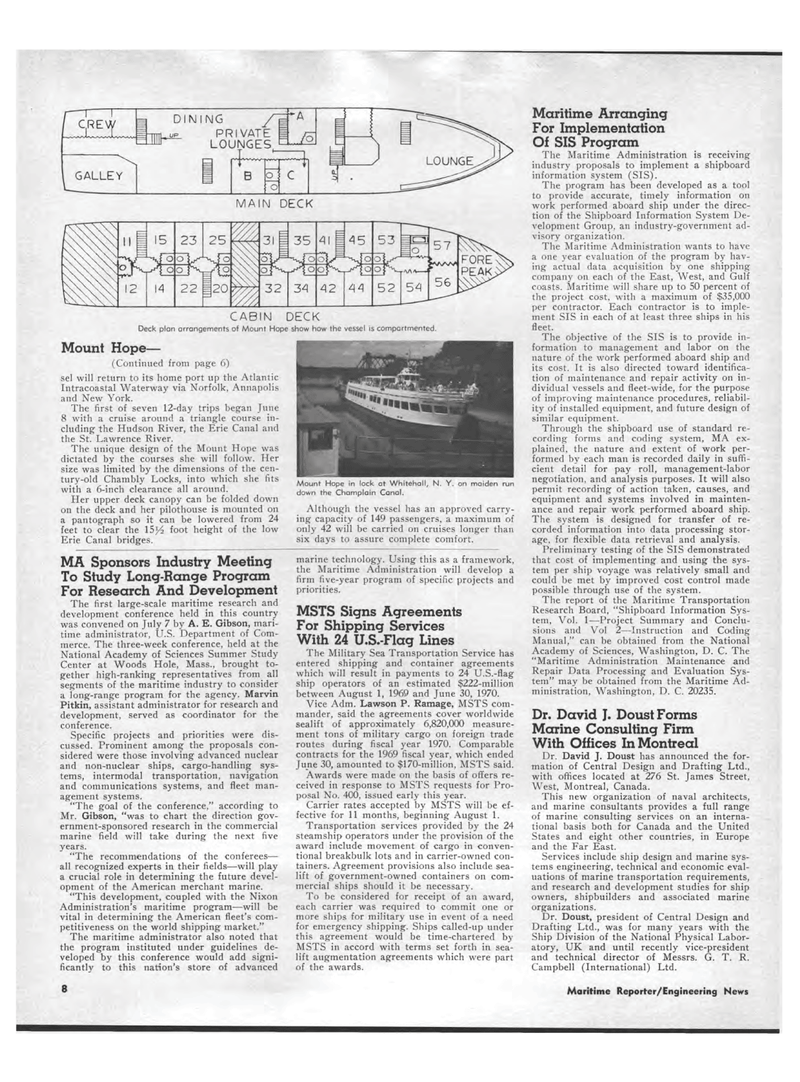
Page 6: of Maritime Reporter Magazine (August 1969)
Read this page in Pdf, Flash or Html5 edition of August 1969 Maritime Reporter Magazine
C.RE lMH^ DINING / PRIVATE LOUNGES M GALLEY ?^VWVW-T B o C o MAIN DECK CABIN DECK Deck plan arrangements of Mount Hope show how the vessel is compartmented. Mount Hope? (Continued from page 6) sel will return to its home port up the Atlantic Intracoastal Waterway via Norfolk, Annapolis and New York. The first of seven 12-day trips began June 8 with a cruise around a triangle course in-cluding the Hudson River, the Erie Canal and the St. Lawrence River. The unique design of the Mount Hope was dictated by the courses she will follow. Her size was limited by the dimensions of the cen-tury-old Chambly Locks, into which she fits with a 6-inch clearance all around. Her upper deck canopy can be folded down on the deck and her pilothouse is mounted on a pantograph so it can be lowered from 24 feet to clear the \5l/2 foot height of the low Erie Canal bridges. MA Sponsors Industry Meeting To Study Long-Range Program For Research And Development The first large-scale maritime research and development conference held in this country was convened on July 7 by A. E. Gibson, mari-time administrator, U.S. Department of Com-merce. The three-week conference, held at the National Academy of Sciences Summer Study Center at Woods Hole, Mass., brought to-gether high-ranking representatives from all segments of the maritime industry to consider a long-range program for the agency. Marvin Pitkin, assistant administrator for research and development, served as coordinator for the conference. Specific projects and priorities were dis-cussed. Prominent among the proposals con-sidered were those involving advanced nuclear and non-nuclear ships, cargo-handling sys-tems, intermodal transportation, navigation and communications systems, and fleet man-agement systems. "The goal of the conference," according to Mr. Gibson, "was to chart the direction gov-ernment-sponsored research in the commercial marine field will take during the next five years. "The recommendations of the conferees?-all recognized experts in their fields?will play a crucial role in determining the future devel-opment of the American merchant marine. "This development, coupled with the Nixon Administration's maritime program?will be vital in determining the American fleet's com-petitiveness on the world shipping market." The maritime administrator also noted that the program instituted under guidelines de-veloped by this conference would add signi-ficantly to this nation's store of advanced Mount Hope in lock at Whitehall, N. Y. on maiden run down the Champlain Canal. Although the vessel has an approved carry-ing capacity of 149 passengers, a maximum of only 42 will be carried on cruises longer than six days to assure complete comfort. marine technology. Using this as a framework, the Maritime Administration will develop a firm five-year program of specific projects and priorities. MSTS Signs Agreements For Shipping Services With 24 U.S.-Flag Lines The Military Sea Transportation Service has entered shipping and container agreements which will result in payments to 24 U.S.-flag ship operators of an estimated $222-million between August 1, 1969 and June 30, 1970. Vice Adm. Lawson P. Ramage, MSTS com-mander, said the agreements cover worldwide sealift of approximately 6,820,000 measure-ment tons of military cargo on foreign trade routes during fiscal year 1970. Comparable contracts for the 1969 fiscal year, which ended June 30, amounted to $170-million, MSTS said. Awards were made on the basis of offers re-ceived in response to MSTS requests for Pro-posal No. 400, issued early this year. Carrier rates accepted by MSTS will be ef-fective for 11 months, beginning August 1. Transportation services provided by the 24 steamship operators under the provision of the award include movement of cargo in conven-tional breakbulk lots and in carrier-owned con-tainers. Agreement provisions also include sea-lift of government-owned containers on com-mercial ships should it be necessary. To be considered for receipt of an award, each carrier was required to commit one or more ships for military use in event of a need for emergency shipping. Ships called-up under this agreement would be time-chartered by MSTS in accord with terms set forth in sea-lift augmentation agreements which were part of the awards. Maritime Arranging For Implementation Of SIS Program The Maritime Administration is receiving industry proposals to implement a shipboard information system (SIS). The program has been developed as a tool to provide accurate, timely information on work performed aboard ship under the direc-tion of the Shipboard Information System De-velopment Group, an industry-government ad-visory organization. The Maritime Administration wants to have a one year evaluation of the program by hav-ing actual data acquisition by one shipping company on each of the East, West, and Gulf coasts. Maritime will share up to 50 percent of the project cost, with a maximum of $35,000 per contractor. Each contractor is to imple-ment SIS in each of at least three ships in his fleet. The objective of the SIS is to provide in-formation to management and labor on the nature of the work performed aboard ship and its cost. It is also directed toward identifica-tion of maintenance and repair activity on in-dividual vessels and fleet-wide, for the purpose of improving maintenance procedures, reliabil-ity of installed equipment, and future design of similar equipment. Through the shipboard use of standard re-cording forms and coding system, MA ex-plained, the nature and extent of work per-formed by each man is recorded daily in suffi-cient detail for pay roll, management-labor negotiation, and analysis purposes. It will also permit recording of action taken, causes, and equipment and systems involved in mainten-ance and repair work performed aboard ship. The system is designed for transfer of re-corded information into data processing stor-age, for flexible data retrieval and analysis. Preliminary testing of the SIS demonstrated that cost of implementing and using the sys-tem per ship voyage was relatively small and could be met by improved cost control made possible through use of the system. The report of the Maritime Transportation Research Board, "Shipboard Information Sys-tem, Vol. 1?Project Summary and Conclu-sions and Vol 2?Instruction and Coding Manual," can be obtained from the National Academy of Sciences, Washington, D. C. The "Maritime Administration Maintenance and Repair Data Processing and Evaluation Sys-tem" may be obtained from the Maritime Ad-ministration, Washington, D. C. 20235. Dr. David J. Doust Forms Marine Consulting Firm With Offices In Montreal Dr. David J. Doust has announced the for-mation of Central Design and Drafting Ltd., with offices located at 276 St. James Street, West, Montreal, Canada. This new organization of naval architects, and marine consultants provides a full range of marine consulting services on an interna-tional basis both for Canada and the United States and eight other countries, in Europe and the Far East. Services include ship design and marine sys-tems engineering, technical and economic eval-uations of marine transportation requirements, and research and development studies for ship owners, shipbuilders and associated marine organizations. Dr. Doust, president of Central Design and Drafting Ltd., was for many years with the Ship Division of the National Physical Labor-atory, UK and until recently vice-president and technical director of Messrs. G. T. R. Campbell (International) Ltd. 8 Maritime Reporter/Engineering News

 5
5

 7
7
